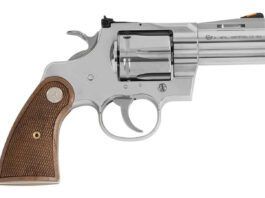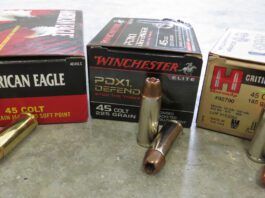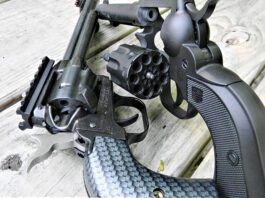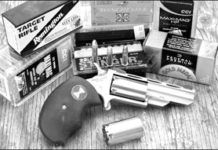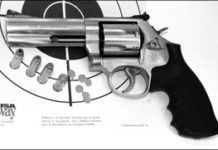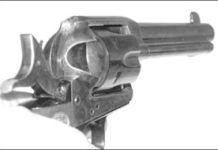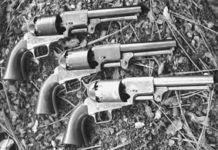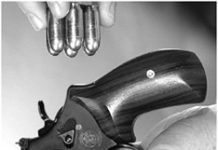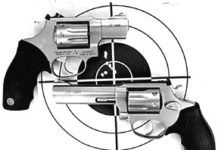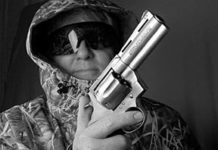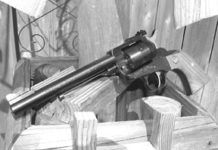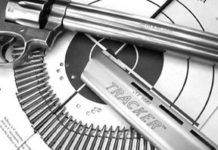Pink Personal Protection Power
Colt Melby Retires from S&W Board of Directors
Pocketable .22 Mags: Three Guns Wed Take a Pass On
.357 Magnum Revolvers: S&W Easily Outdoes Czech Import
In our August 2006 issue we reviewed three different .357 Magnum revolvers with 4-inch barrels. The 4-inch magnum is the traditional configuration for the uniformed policeman, and despite the overload of semi-autos now available, the revolver is still a popular sidearm. Each of the guns in our first test, the $615 Ruger GP100, Taurus's $469 M66SS4, and the $646 Smith & Wesson Model 619 were made in the United States.
Since then we have come across a foreign made product that begs comparison to these guns. This was the Alfa Steel .357 Magnum manufactured in Czechoslovakia. We also decided to revisit the Smith & Wesson catalog and test the seven-shot model 686 Plus, catalog number 164194 ($790). Both guns featured a full underlug that enclosed the ejector rod and added recoil-opposing weight beneath the barrel. Each gun offered a ramped front sight with orange-colored insert and a rear sight that was adjustable for windage and elevation. Both guns used a flat-faced hammer and frame-mounted firing pin. Other similarities included finger-grooved grips and counter-clockwise rotation of the cylinder.
Let's see how well this newcomer stacks up against the field.
A Fine Brace of .38 Cowboy Six-Shooters: Daly Beats AWA
Cowboy Action shooters might well consider choosing a .38 Special for their activities if they have even the slightest trouble with recoil from the .45s. Recoil recovery plays a big part in Cowboy competition, speed being mighty important for best scores. We tested a few other .38 Special/.357 Magnum single actions recently, and here we have two more. These are the American Western Arms Ultimate 1873, all blued, for $600, and the Charles Daly 1873 Standard Model, $460. Both have 5.5-inch barrels, and both are made by Pietta in Italy. There are similarities, but the differences are plain to see. Here's what we found.
Best Tested Firearms: Revolvers
Ruger lists seven different models in the GP100 family with barrel lengths of 3, 4, and 6 inches. Finishes are either blued or stainless steel. Manufacturer's suggested retail prices range from $552 for the .38 Special +P only models to $615 for the stainless steel .357 Magnum revolvers with barrel lengths of either 4 or 6 inches.
Second Dragoons On Trial: We Rank Cimarron, Colt, and EMF
The Second Dragoon was the middle of three post-Walker revolvers developed by Colt beginning in 1848. All were designed for horseback use, and as such, weight was not much of a consideration, though at 4 pounds, the Dragoons weighed half a pound less than the Walker. There also was, most likely, ignorance about how heavy a revolver had to be in order to handle a given power level. For example, the 1860 Army Colt was not a lot less powerful than the Dragoon but weighed far less, yet was totally controllable, the result of ten years of refinement.
The Dragoon name comes from the use, or designated use, of this heavy pistol by the U.S. Mounted Rifles, some of which were called the Dragoons. Most originals, and all of our test trio, had the initials U.S.M.R. engraved on the cylinders. The Second Dragoon was in production from 1850-51, with a total of about 2,700 made. The First Dragoon was made from 1848 to 1850 in the quantity of about 7,000, and the Third Dragoon was made for about ten years, in the quantity of about 10,500. This makes the Second Dragoon the rarest of the original 4-pound Colts. In a similar manner, when Colt organized the production of the 2nd-Generation Dragoons in the early 1980s (built by Iver Johnson from I-J and Uberti parts), they made nearly 4,000 of the First, close to 7,000 of the Third, but only 2676 of the Second Dragoon, again rendering them the rarest of the lot. Easily distinguished by the square-back trigger guard and the rectangular bolt-stop notches, the Second Model Dragoon was originally presented with blued barrel, cylinder and trigger, and case-colored loading lever, hammer, and frame. The grip straps were brass, and grips were one-piece walnut. Some martial-use pistols had grips marked with an inspector's escutcheon. Our test EMF has such a mark.
Super-Light Wheelguns for Self Defense: Too Much Power?
The guns in this test — Smith & Wesson's .45 ACP 325PD and .357 Magnum 327, and the Taurus .41 Magnum 451 — all have problems that would make us think twice before buying them.
Small-Frame .17 HMR Revolvers: Two Guns We Can Live Without
Taurus's latest $406 .17 HMR revolvers shoot accurately but cannot overcome cartridge-related problems.
Versatile Four-Inch Forty-Bore Revolvers: Big Snake Charms Us
Smith & Wesson's $833 Model 610 10mm/.40 S&W is a slick shooter, but the $1000 Colt Anaconda in .44 Special/.44 Magnum is better than ever, in our estimation.
.17 HMR Revolvers, Part Two: We Test Single-Action Ruger, Heritage Wheelguns
Last month's test of double-action revolvers showed two guns that suffered cylinder bind. This round, we encountered no problems whatsoever with the simpler models.
Sticky Situations: Two Revolvers Chambered for the .17 HMR
Many companies have shown they can chamber revolvers with nearly any length of cartridge, but there can still be problems — in particular, maintaining headspace, the distance between the head of the cartridge and the breechface. The cause: Narrow chambers fill with debris, making complete chambering difficult. This can hamper rotation and present a safety hazard. This is especially true of rimfires, unlike a centerfire round whose primer is recessed and protected by the case. With a rimfire, there has always been concern that hitting the case edge on the breech while closing the cylinder could ignite the cartridge.
We noted function (but not safety) problems when we recently tested two double-action guns chambered for the .17 Hornady Magnum Rifle cartridge: the Smith & Wesson Model 647, $677; and the Taurus International M17 Tracker, $438. Next month, we look at two single-action revolvers chambered for the increasingly popular round.
The .17 HMR has been described as a Winchester Magnum Rifle (WMR) case necked down in the final 0.2 inches of its length to secure a boattail rifle bullet measuring approximately 0.17 inch in diameter. Given the higher velocity of this round compared to the .22 WMR, we wanted to know if accuracy would be effected pro or con. Also, would the unique profile of this rimfire round solve headspacing problems or create new ones? We began shooting to find out:



























